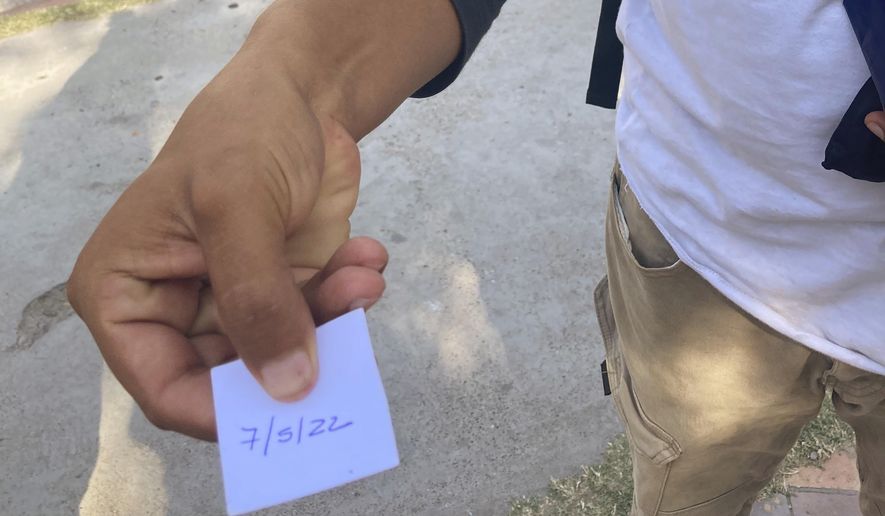PIEDRAS NEGRAS, Mexico — Opaque waiting lists at the Mexico border to gain a chance at obtaining asylum in the United States have persisted under President Joe Biden, leading many migrants to give up and cross illegally or languish for months in border towns.
U.S. preparations in late April to end pandemic-related limits on asylum led to the latest round of registering names. In Tijuana, an online registry run by advocacy group Al Otro Lado soared to about 50,000. In Piedras Negras, a migrant services center’s list ballooned to 2,000 before being halted.
Waiting lists were widely used under former President Donald Trump to deal with an increase in migrants from Mexico and Central America coming to the border, starting with large caravans in 2018. Circumstances are different now, but the process is similarly confusing. Migrants often don’t know how to sign up or that lists even exist.
The latest chaotic episodes come as a spike in border crossings has become a political flashpoint for Biden, with Republicans saying he’s not doing enough to stop them. At a meeting with Biden in Washington on Tuesday, Mexican President Andres Manuel López Obrador spoke of challenges that were brutally underscored by 53 migrants who died last month after being abandoned in a sweltering tractor-trailer in San Antonio.
U.S. Customs and Border Protection began taking 70 asylum-seekers a day in San Diego in late April - half chosen by Al Otro Lado, which prioritizes how long migrants have waited, and half by Border Angels, which selected from Tijuana migrant shelters.
The Biden administration says it prioritizes the most “vulnerable” - which may include LGTBQ migrants, those with severe medical conditions or those facing imminent physical danger in Mexico - but the criteria is vague and mysterious for many.
Nongovernmental organizations play a “critical role,” helping select migrants and communicating with U.S. authorities, CBP Commissioner Chris Magnus said in a recent interview.
“Is it a perfect system? Certainly not, but that has been a very important part of the equation, these relationships,” Magnus said.
When U.S. authorities told a small shelter in Ciudad Acuña that they wanted 26 families at the border crossing with Del Rio, Texas, false word spread that Magaly Pérez, director of the San Antonio Community Center, was managing a list.
“The next day we had 100 people at the door,” Pérez said. “The day after that we had 300 people. It spun out of control.”
Haphazard, often-dubious arrangements popped up along the border under Trump’s administration. In Ciudad Juarez, across from El Paso, Texas, a migrant shelter registered asylum-seekers by writing numbers on their arms with black ink. After widespread criticism, migrants instead were given numbered plastic wristbands, some of which were sold or given away.
In San Luis Rio Colorado, near Yuma, Arizona, an asylum-seeker who managed a list picked a successor when his number came up. In Piedras Negras, the city government named the owner of a local steakhouse to oversee its list.
The Biden administration maintained Trump’s policy of denying migrants a chance to seek asylum on grounds of preventing spread of COVID-19, and a federal judge’s order has kept the pandemic-related authority known as Title 42 authority in place after it was due to expire on May 23.
The U.S. grants some exemptions to Title 42, but the rule has been unevenly enforced by nationality, with single adults and families from Mexico, Guatemala, Honduras and El Salvador most affected.
The U.S. accepted an average of 423 migrants a day at official crossings in May, 308 in March and 418 in February, according to court filings. April’s daily average of 1,614 was inflated by a temporary increase from Ukraine.
Migrants getting picked from Al Otro Lado’s list typically registered a year ago, Soraya Vazquez, deputy director of advocacy for the group’s office in Tijuana, said. The group also works remotely with migrants in Piedras Negras and other select other border cities.
A survey by the University of Texas’ Strauss Center tallied 27,135 names on waiting lists in eight Mexico border cities in May - before Al Otro Lado’s soared to about 50,000 by late June.
An orderly system will be critical if Title 42 ends, and CBP is exploring an online platform.
In Piedras Negras, Isis Peña, 45, of Honduras registered on Casa del Migrante’s short-lived waiting list on April 29. When she came for her interview five days later, she was told openings to claim asylum were no longer available. “We wanted someone to give us hope,” said Peña, who later crossed illegally to Eagle Pass with her 19- and 20-year-old sons and was expelled under Title 42.
Peña - whose family is now homeless and scrounging for food - latches on to frequent, unfounded rumors that the Biden administration is about to open the border.
“The information is very complicated, and the ways to access the system are very complicated,” said Edgar Rodriguez, Casa del Migrante’s legal advisor.
A lack of shelters means many of the roughly 300 largely Honduran migrants who line up for takeout hot breakfasts six mornings a week at Casa del Migrante sleep outside.
As a group of women waited for food in June, one joyfully shared a text message from an Al Otro Lado attorney: “Congratulations! You have been approved for humanitarian parole.” It included instructions to report to the Eagle Pass border crossing the next day at 5 a.m.
Kenia Carcamo, who was expelled from Eagle Pass under Title 42, never heard of the list.
“It’s a lucky roulette,” Carcamo said.
Joan Leiva, a gay man who fled persecution in Honduras, enrolled with Al Otro Lado in May and slept in a park in Ciudad Acuña until police kicked out migrants.
“We are adrift,” Leiva, 31, said. “We don’t know where to go to ask for information. No one tells us.”




Please read our comment policy before commenting.